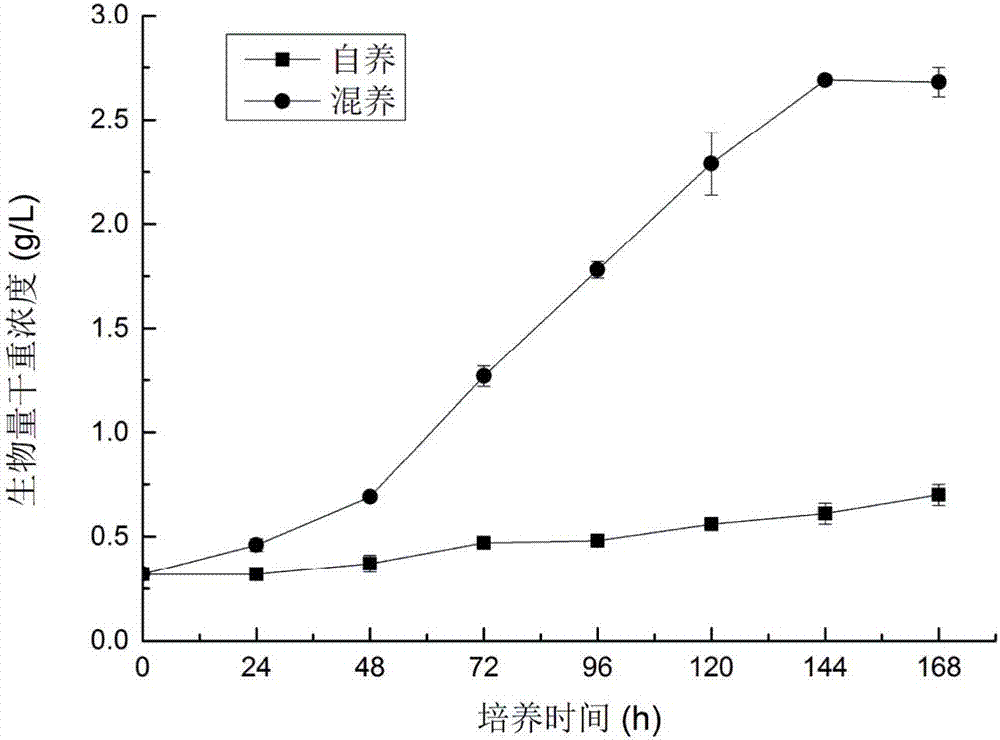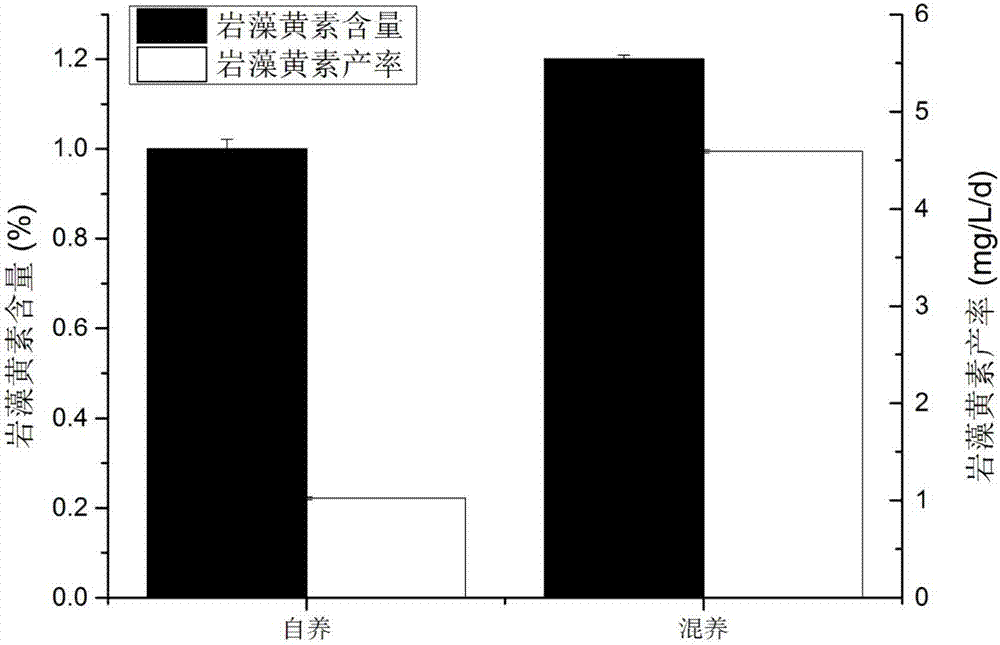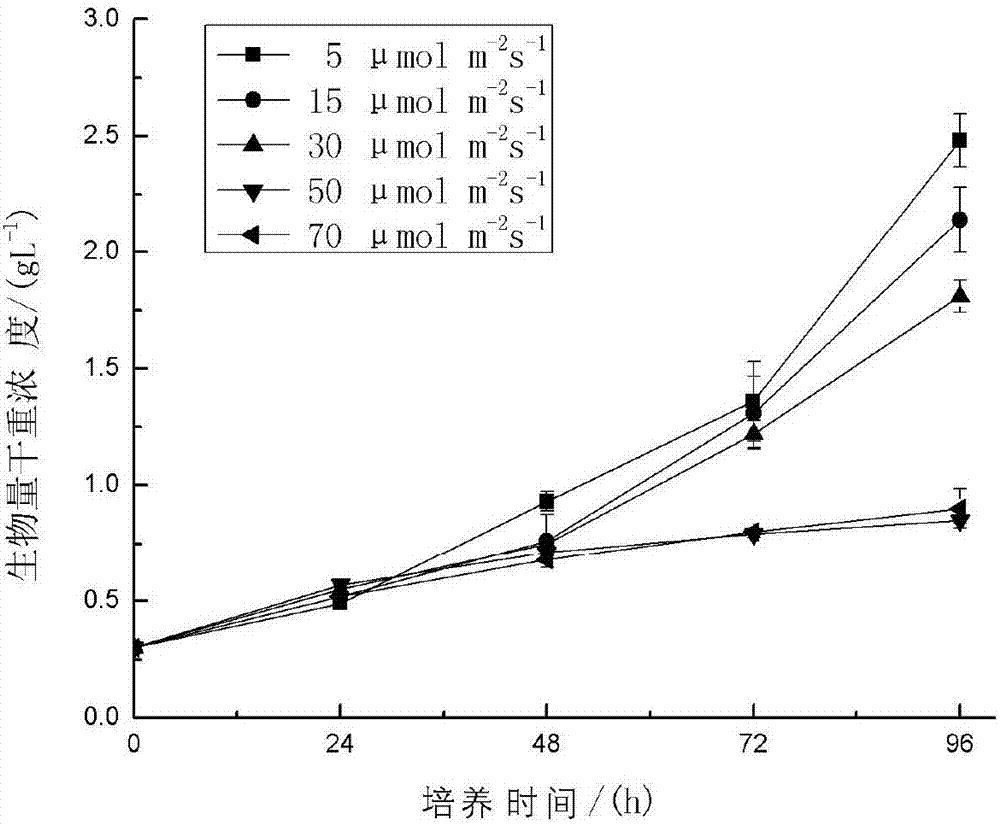Method for producing fucoxanthin through light culture of nitzchia laevis
A technology of fucoxanthin and light culture, applied in the direction of microorganism-based methods, biochemical equipment and methods, microorganisms, etc., can solve the difficulties of industrial application, optimization of uncultivated conditions, and low yield of fucoxanthin in biomass concentration and other issues to achieve the effect of shortening the production cycle, reducing production costs, and reducing pollution risks
- Summary
- Abstract
- Description
- Claims
- Application Information
AI Technical Summary
Problems solved by technology
Method used
Image
Examples
Embodiment 1
[0051] Autotrophic culture of Rhizobium smoothie
[0052] The production strain was Nitzschia laevis UTEX 2047 (purchased from the Microalgae Collection of the University of Texas at Austin, Culture Collection of Algae at The University of Texas at Austin, UTEX for short).
[0053] The process steps are as follows:
[0054] A, by inoculating the rhizoma smoothie of the activated bacterial classification in the sterile seed medium that is placed in the shake flask, heterotrophic culture is made for 3 days to make the seed liquid, and the rhomboid rhizomes cell is in the logarithmic growth phase in the seed liquid;
[0055] B. Take a 250mL conical flask as a culture vessel, transfer into 100mL of fermentation medium and sterilize. According to the inoculum volume ratio of 10%, the seed liquid in step A is inserted into the sterile fermentation medium for autotrophic culture on a shaker to prepare a fermentation broth. The culture conditions are as follows: the light intensity i...
Embodiment 2
[0062] Polyculture of Rhizobium smoothie
[0063] The difference between Example 2 and Example 1 is that the seed medium and the fermentation medium in Example 2 also contain the following raw materials: glucose 5 g / L, and other contents are the same as those in Example 1.
[0064] The effect analysis of embodiment 1,2:
[0065] Compared with the autotrophic and polyculture conditions, the growth state of the polyculture was better, the polyculture biomass was up to 2.68g / L, and the autotrophy was only 0.70g / L (see figure 1 ). like figure 2 , the autotrophic fucoxanthin content was 1.0%, and the polyculture was up to 1.2%. The calculated yield of fucoxanthin in polyculture was higher than that in autotrophy, and the optimal yield was 4.59 mg / (L·d).
Embodiment 3
[0067] Polyculture of Rhizobium smoothie
[0068] The difference between Example 3 and Example 2 is that the seed medium and the fermentation medium also contain the raw materials of the following content: glucose 20g / L, and the production strain selects Nitzschia laevis CCMP 559 (purchased from U.S. Marine Microorganisms). Algae and Microorganisms Collection Center, National Center for Marine Algae and Microbiota, referred to as NCMA), other contents are the same as Example 2.
[0069] Effect analysis of embodiment 3:
[0070] The production strain in this example has a good growth state, and the biomass is up to 2.88g / L. The autotrophic fucoxanthin content was 0.9%. It is calculated that the yield of fucoxanthin produced by fermentation of the production strain in this example is higher than that of autotrophy, and the optimal yield is 4.32 mg / (L·d).
PUM
 Login to View More
Login to View More Abstract
Description
Claims
Application Information
 Login to View More
Login to View More - R&D
- Intellectual Property
- Life Sciences
- Materials
- Tech Scout
- Unparalleled Data Quality
- Higher Quality Content
- 60% Fewer Hallucinations
Browse by: Latest US Patents, China's latest patents, Technical Efficacy Thesaurus, Application Domain, Technology Topic, Popular Technical Reports.
© 2025 PatSnap. All rights reserved.Legal|Privacy policy|Modern Slavery Act Transparency Statement|Sitemap|About US| Contact US: help@patsnap.com



